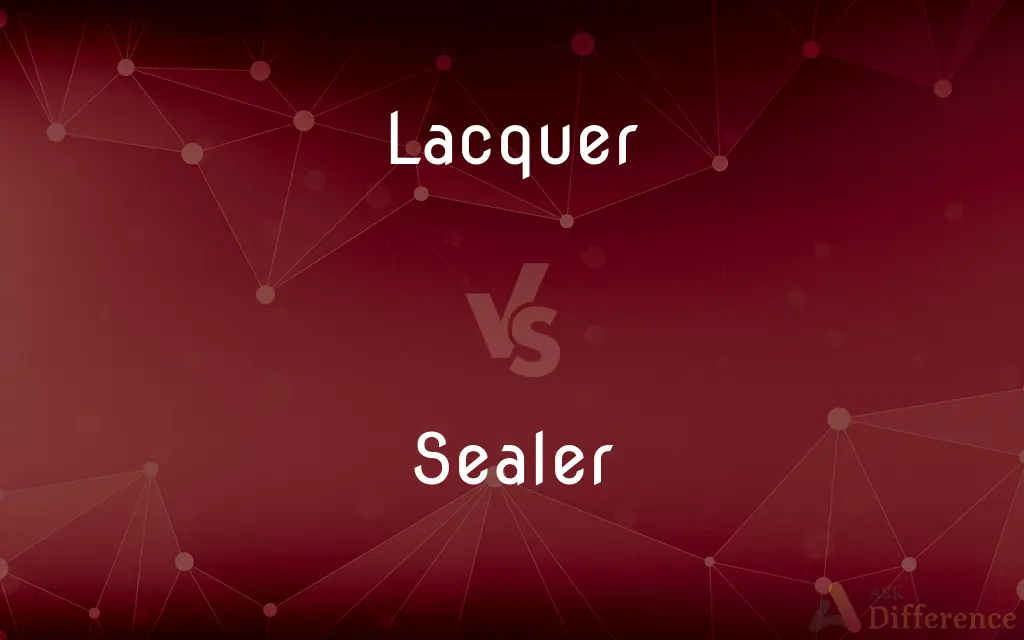Lacquer vs. Sealer — What's the Difference?
By Fiza Rafique & Urooj Arif — Updated on May 6, 2024
Lacquer is a fast-drying coating that provides a hard, durable finish, often with a high gloss, whereas sealers are used primarily to protect and stabilize surfaces, often serving as a base coat.

Difference Between Lacquer and Sealer
Table of Contents
ADVERTISEMENT
Key Differences
Lacquer is known for its ability to dry quickly and form a hard, protective surface, which is often shiny and clear. This makes it popular for use on wood, metal, and other materials needing a durable finish. In contrast, sealers are applied to provide a protective barrier that can stabilize or enhance the underlying material's properties, such as grain in wood.
The application of lacquer typically involves spraying it onto the surface, where it dries by solvent evaporation, creating a solid, tough film. On the other hand, sealers can be applied through various methods, including brushing and spraying, and are designed to penetrate into the substrate, offering protection without necessarily forming a thick surface layer.
Lacquer finishes are often chosen for their aesthetic appeal, as they can enhance the appearance of the surface, providing a high gloss and smooth finish. Whereas, sealers are usually more functional, used to prepare surfaces for further finishing, or to protect from moisture and environmental damage without altering the appearance significantly.
Due to its chemical composition, lacquer is typically less flexible than many sealers and can be susceptible to cracking with age or in response to temperature changes. Sealers, however, often provide a more flexible barrier, accommodating slight movements in the substrate, such as wood expansion or contraction.
Maintenance and repair considerations differ significantly; lacquer finishes, while durable, can be difficult to repair or touch up without redoing the entire surface. Sealers, conversely, can often be reapplied or touched up locally with less risk of visibly contrasting with the original finish.
ADVERTISEMENT
Comparison Chart
Primary Use
Decorative finish with protective qualities
Protective base layer, often preparatory
Application Method
Typically sprayed
Can be brushed, sprayed, or rolled
Finish Characteristics
Hard, glossy, and smooth
Usually matte, does not alter appearance much
Durability
High, but can crack with age
Flexible, adapts to substrate movements
Maintenance
Difficult to touch up without full reapplication
Easier local reapplication and touch-ups
Compare with Definitions
Lacquer
Often applied to wood and metal for its durable and glossy appearance.
The carpenter chose a clear lacquer to showcase the natural wood grain.
Sealer
Does not significantly alter the appearance of the substrate.
The sealer kept the wood's natural look intact while offering moisture protection.
Lacquer
Difficult to repair without noticeable touch-ups.
Fixing the scratched lacquer finish required careful sanding and reapplication.
Sealer
Used to protect and stabilize surfaces, often as a base coat.
Before painting, the artist applied a sealer to the canvas to prevent paint absorption.
Lacquer
A fast-drying coating that forms a hard, protective finish.
The lacquer on the vintage table gleamed under the showroom lights.
Sealer
Can be reapplied or touched up with ease.
After a few years, the sealer on the fence was touched up to maintain its protective qualities.
Lacquer
Susceptible to cracking with environmental changes.
Over time, the lacquer on the old piano began to crack and peel.
Sealer
Enhances or stabilizes underlying material properties without thick layering.
The sealer penetrated the stone patio, enhancing its natural colors while protecting it from stains.
Lacquer
Dries by solvent evaporation, creating a tough layer.
The lacquer dried quickly, making it a preferred choice for rapid project completion.
Sealer
Provides a protective barrier against moisture and damage.
The wood deck was treated with a sealer to protect it from weathering.
Lacquer
The term lacquer is used for a number of hard and potentially shiny finishes applied to materials such as wood or metal. These fall into a number of very different groups.
Sealer
One that seals, as an undercoat of paint or varnish used to size a surface.
Lacquer
Any of various clear or colored synthetic coatings made by dissolving nitrocellulose or other cellulose derivatives together with plasticizers and pigments in a mixture of volatile solvents and used to impart a high gloss to surfaces.
Sealer
An officer who inspects, tests, and certifies weights and measures.
Lacquer
A glossy, resinous material, such as the processed sap of the lacquer tree, used as a surface coating.
Sealer
One that is engaged in the hunting of seals.
Lacquer
A finish that is baked onto the inside of food and beverage cans.
Sealer
A tool used to seal something.
Lacquer
To coat with lacquer.
Sealer
A person who is employed to seal things.
Lacquer
To give a sleek, glossy finish to.
Sealer
An officer responsible for sealing writs or instruments, stamping weights and measures, etc.
Lacquer
A glossy, resinous material used as a surface coating; either a natural exudation of certain trees, or a solution of nitrocellulose in alcohol, etc.
Sealer
A coating designed to prevent excessive absorption of finish coats into porous surfaces; a coating designed to prevent bleeding.
Lacquer
A similar finish, baked onto the inside of cans.
Sealer
A goal, shot, point, etc., scored close to fulltime so that it becomes impossible for the losing side to score enough to win.
Lacquer
To apply a lacquer to something or to give something a smooth, glossy finish.
Sealer
A person who hunts seals.
Lacquer
A varnish, consisting of a solution of shellac in alcohol, often colored with gamboge, saffron, or the like; - used for varnishing metals, papier-maché, and wood. The name is also given to varnishes made of other ingredients, esp. the tough, solid varnish of the Japanese, with which ornamental objects are made.
Sealer
A vessel engaged in the business of capturing seals.
Lacquer
To cover with lacquer.
Sealer
One who seals; especially, an officer whose duty it is to seal writs or instruments, to stamp weights and measures, or the like.
Lacquer
A black resinous substance obtained from certain trees and used as a natural varnish
Sealer
A mariner or a vessel engaged in the business of capturing seals.
Lacquer
A hard glossy coating
Sealer
A kind of sealing material that is used to form a hard coating on a porous surface (as a coat of paint or varnish used to size a surface)
Lacquer
Coat with lacquer;
A lacquered box from China
Sealer
An official who affixes a seal to a document
Common Curiosities
Can sealer be applied over lacquer?
Generally, sealer should not be applied over lacquer as it may not adhere well; the preparation and base layering are crucial for proper finish adherence.
Can lacquer be used as a sealer?
While lacquer provides some sealing properties, it is generally not used as a sealer due to its rigid finish and less penetrative nature.
What is the main difference between lacquer and sealer?
The main difference is their primary use: lacquer is used for creating a durable and decorative finish, while sealer is used primarily to protect and stabilize the surface.
Is sealer necessary under lacquer?
Using a sealer under lacquer can be beneficial as it stabilizes the wood and ensures a smoother, more durable lacquer finish.
Which lasts longer, lacquer or sealer?
Both can be long-lasting, but lacquer tends to show age through cracking and peeling, whereas sealers can be more flexible and easier to maintain.
How do I choose between lacquer and sealer for a project?
The choice depends on the project's needs: lacquer for a hard, glossy finish and sealer for protection and surface preparation.
Can both lacquer and sealer be used indoors and outdoors?
Both can be used indoors; however, specific formulations are required for outdoor use, especially for lacquer, to ensure durability against weather elements.
What safety precautions are necessary when using lacquer or sealer?
Adequate ventilation, protective clothing, and masks are important due to fumes and chemical exposure.
How often should lacquer and sealer be reapplied?
Lacquer generally does not need frequent reapplication unless damaged, while sealer might need reapplication depending on exposure conditions and wear.
Are there eco-friendly versions of lacquer and sealer?
Yes, water-based and low-VOC versions of both lacquer and sealer are available for environmentally conscious choices.
What are the advantages of using a sealer?
The advantages include substrate stabilization, moisture protection, and improved adhesion for subsequent finishing layers.
How do lacquer and sealer react to heat and moisture?
Lacquer can be vulnerable to heat and moisture, potentially leading to finish damage; sealers generally provide better protection against these elements.
What surfaces are best for lacquer?
Lacquer is best for hard, smooth surfaces like wood and metal where a glossy finish is desired.
How do environmental conditions affect lacquer and sealer?
Lacquer can be sensitive to temperature and humidity changes, potentially cracking, while sealer is more adaptable to environmental changes.
Is special equipment required to apply lacquer or sealer?
Spraying equipment is often recommended for lacquer for a smooth finish, whereas sealers can often be applied with brushes or rollers.
Share Your Discovery

Previous Comparison
Amplify vs. Magnify
Next Comparison
Rebellion vs. SubversionAuthor Spotlight
Written by
Fiza RafiqueFiza Rafique is a skilled content writer at AskDifference.com, where she meticulously refines and enhances written pieces. Drawing from her vast editorial expertise, Fiza ensures clarity, accuracy, and precision in every article. Passionate about language, she continually seeks to elevate the quality of content for readers worldwide.
Co-written by
Urooj ArifUrooj is a skilled content writer at Ask Difference, known for her exceptional ability to simplify complex topics into engaging and informative content. With a passion for research and a flair for clear, concise writing, she consistently delivers articles that resonate with our diverse audience.













































